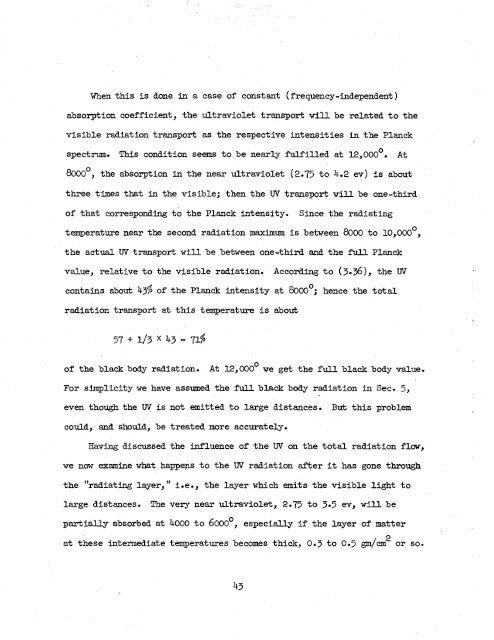Theory of the Fireball
Theory of the Fireball
Theory of the Fireball
You also want an ePaper? Increase the reach of your titles
YUMPU automatically turns print PDFs into web optimized ePapers that Google loves.
When this is done in a case <strong>of</strong> constant ( frequency-independent )<br />
absorption coefficient, <strong>the</strong> ultraviolet transport will be related to <strong>the</strong><br />
visible radiation transport as <strong>the</strong> respective intensities in <strong>the</strong> Planck<br />
spectrum. This condition seems to be nearly fulfilled at 12,000°. At<br />
8000°, <strong>the</strong> absorption in <strong>the</strong> near ultraviolet (2.75 to 4.2 ev) is about<br />
three tines that in <strong>the</strong> visible; <strong>the</strong>n <strong>the</strong> W transport will be one-third<br />
<strong>of</strong> that corresponding to <strong>the</strong> Planck intensity. Since <strong>the</strong> radiating<br />
temperature near <strong>the</strong> second radiation maximum is between 8000 to 10,OOOo,<br />
<strong>the</strong> actual W transport will be between one-third and <strong>the</strong> full Planck<br />
value, relative to <strong>the</strong> visible radiation. According to (3.36), <strong>the</strong> W<br />
contains about 43$ ,<strong>of</strong> <strong>the</strong> Planck intensity at 8000'; hence <strong>the</strong> total<br />
radiation transport at this temperature is about<br />
<strong>of</strong> <strong>the</strong> black body radiation. At 12,000° we get <strong>the</strong> full black body value.<br />
For simplicity we have assumed <strong>the</strong> full black body radiation in Sec. 5, i<br />
even though <strong>the</strong> W is not emitted to large distances. But this problem<br />
could,. and should, be treated more accurately.<br />
Having discussed <strong>the</strong> influence <strong>of</strong> <strong>the</strong> W on <strong>the</strong> total radiation flow,<br />
we nuw examine what happens to <strong>the</strong> W radiation after it has gone through<br />
If<br />
<strong>the</strong> "radiating layer, i.e., <strong>the</strong> layer which emits <strong>the</strong> visible light to<br />
large distances. The very near ultraviolet, 2.75 to 3.5 ev, wiU. be<br />
partially absorbed at 4000 to 6000°, especially if <strong>the</strong> layer <strong>of</strong> matter<br />
2<br />
at <strong>the</strong>se intermediate temperatures becomes thick, 0.3 to 0.5 gm/cm or SO.<br />
/<br />
43
















